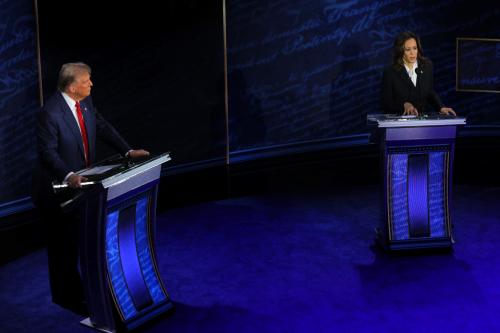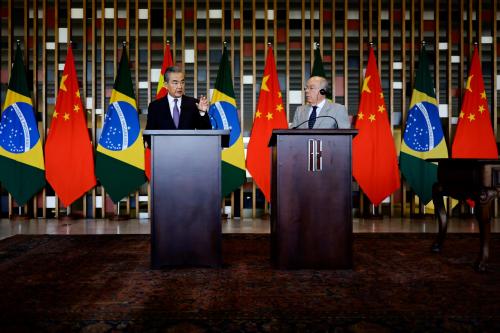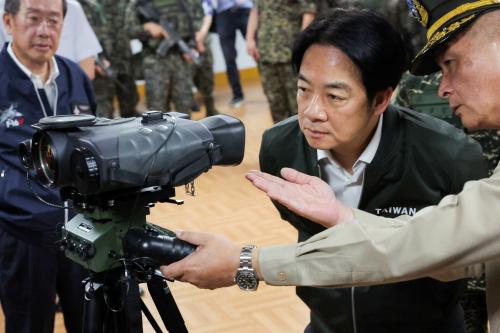Executive summary
A surge in violent conflicts globally is consuming scarce diplomatic, military, and financial resources; emboldening revisionist actors; and threatening U.S. national security objectives. At the same time, two decades of failed investments in places like Afghanistan have left U.S. policymakers wary of ambitious stabilization projects and discredited the assumption that the United States can and should stabilize all fragile states. In an era of growing major-power competition and global challenges like climate change, the United States needs a more efficient, effective approach to mitigating the consequences of the most destabilizing conflicts if it is going to realize its goal of navigating the current geopolitical transition toward a more stable global equilibrium.
A more targeted focus on conflict prevention provides a compelling solution to this challenge. Research has demonstrated that preventative action is both an effective and efficient way to reduce conflict.1 By mitigating the greatest threats to U.S. national security objectives while avoiding overstretch and conserving U.S. bandwidth to manage major power competition and other global challenges, a prevention approach is uniquely suited to the current geopolitical environment. But there are inherent obstacles to implementing prevention and as a result, preventative action is often missing, insufficient, or too late. These obstacles are in part psychological, economic, and bureaucratic: Individuals and organizations must overcome the natural tendency to be consumed by the tyranny of the immediate, invest scarce resources in the present for an uncertain future reward, and overcome the bureaucratic bias against proactive action. While existing literature provides useful guidance on the most effective technical approaches to prevention, it largely fails to provide practical solutions to overcoming these inherent obstacles to preventative action and institutionalizing prevention within a bureaucracy.
The current geopolitical environment increases the imperative of conflict prevention, but in practice, it also exacerbates these obstacles and makes conflict prevention more difficult to implement. Some recent U.S. conflict prevention initiatives have struggled in the current U.S. foreign policy environment, in part because of persistent, problematic assumptions that the United States is capable of transforming countries independently, without local leadership, and that fragility anywhere poses a threat to the United States. In fact, a fragility lens can itself be problematic, recognizing that not all countries experiencing conflict were previously considered fragile, including some conflicts that pose significant threats to U.S. national security.
This paper seeks to offer a practical guide for policymakers to overcome obstacles to preventative action, including by adjusting to current U.S. foreign policy and geopolitical realities. In doing so, it applies a bureaucratic lens rather than a technical one, recognizing that practical impediments are just as critical to the success of prevention efforts as technical considerations. While this paper focuses on the United States, effective conflict prevention demands collaboration across U.N. member states and with international and regional organizations. For this reason, the recommendations aim to be useful for other member states and institutions seeking to strengthen their conflict prevention efforts. My research is based on over 70 interviews with current and former government officials, congressional staffers, and other experts, and it leverages the experience from a few, highly instructive recent U.S. experiences.
The paper references a companion case study of U.S. policy in Yemen between 2011 and 2015 to illustrate how the U.S. ability to prevent conflict manifests in practice and what is necessary to seize those opportunities for prevention, given widespread assumptions that the U.S. could have done more to prevent the Yemen war in 2015. The case study underscores that effective conflict prevention requires more adaptive, responsive U.S. policymaking processes. The United States had three brief windows of opportunity between 2011-2015 to prevent or mitigate the Yemen war. Seizing those opportunities would have required the United States to elevate conflict prevention alongside other proximate policy goals and to be better at:
- Weighing medium-term consequences of policy decisions over short-term imperatives.
- Updating its assumptions and corresponding policy positions in response to rapidly changing dynamics on the ground.
- Quickly mobilizing leadership attention and action.
In no case were individual foreign policy tools such as foreign assistance the defining factor in the U.S. ability to prevent or mitigate conflict. Rather, it depended on policy decisions—or the failure to make a decision.
The paper also assesses the implementation of the Global Fragility Act, legislation from 2019 that represents the most ambitious recent U.S. attempt to implement a conflict prevention initiative, to better understand obstacles to prevention in the United States and how they can be overcome. I find that GFA implementation is siloed and primarily focused on enhancing U.S. foreign assistance rather than shaping U.S. foreign policy in the GFA pilot countries, and thus, it is unlikely to shape the trajectory of conflict at the national level. The administration’s decision to house the GFA in technical offices that lack authority over policymaking or all relevant foreign policy tools, the legislation’s focus on programmatic resources rather than necessary operational ones, and the relatively weak strategic rationale for GFA efforts in the pilot countries (driven in part by the persistent problematic assumptions noted above), all contributed to the constraints faced by the GFA.
Experience from other U.S. prevention-related initiatives, namely the atrocity prevention process and Middle East Partnership Initiative, underscores that a weak strategic rationale will undermine the impact of an initiative, regardless of where it is institutionalized and how much support it has from senior U.S. officials or Congress, as well as the danger of projectization of initiatives that depend on changes in U.S. policy. Recent experience from a new State Department initiative—the Policy Risk and Opportunity Planning (PROP) group provides a model for how to demonstrate a stronger strategic rationale. At the same time, the GFA’s focus on institutionalization will bolster the sustainability of the initiative, and the GFA and the atrocity prevention process demonstrate how congressional support can sustain initiatives across changes in administration.
Using the lessons from these cases, I develop a blueprint for what I call a calibrated conflict prevention approach. This approach assumes that that the United States is only capable of preventing conflict in select cases and often only during narrow windows, and that the U.S. does not have a strong national security rationale for preventing conflict in all cases. The tools and structures in this approach are designed to be effective whether the United States is confronting emerging conflicts embroiled in major power competition, such as Taiwan, or those occurring in highly fragile states like the Democratic Republic of Congo. A calibrated conflict prevention approach focuses on adjusting U.S. policymaking processes to make them more adaptive and responsive rather than on how officials wield individual foreign policy tools like foreign assistance. It is structured to emphasize a strong national security rationale and provide the necessary authorities, resources, and incentives for making such adjustments to U.S. foreign policy in the targeted countries. The key elements of this approach include:
-
A focus on just-in-time prevention of emerging conflicts, in addition to the long- term conflict prevention efforts that are the focus of most prevention initiatives, including the GFA. I argue that just-in-time prevention is effective, will present a stronger strategic rationale, and can provide the nearer-term results necessary to build policymaker buy-in.
-
Systemic bureaucratic reforms to mitigate impediments to prevention, including those related to staffing and the U.S. diplomatic security posture. Combined with just-in-time prevention and long-term prevention efforts in priority countries, these make up what I call the prevention pyramid.
-
A stricter targeting process for selecting priority countries based on U.S. national security goals and the potential for U.S. impact, building on the model used by the atrocity prevention process and PROP group.
-
Tools for reforming U.S. policymaking processes in the targeted countries, including a critical assessment of the existing U.S. policy posture, a single streamlined strategic approach, and flexible processes for regularly evaluating U.S. efforts and developments on the ground. These tools can help bureaucracies that were designed to manage the more stable portfolios that make up the bulk of major U.S. bilateral relationships become more adaptive and responsive and overcome a bias toward maintaining the status quo in diplomatic engagement.
-
Oversight by an empowered secretariat that includes offices with authority and influence over policymaking in the targeted countries, as well as relevant foreign policy tools.
-
Dedicated operational resources and authorities to ensure the initiative has the right staff to enable a more adaptive, responsive U.S. approach and to provide effective incentives to strengthen buy-in for the initiative. This is a departure from initiatives like the GFA that have instead focused on surging foreign assistance resources.
-
Footnotes
- In this paper, I define conflict prevention as intervention that occurs prior to a major escalation of violence. This intervention can seek to address the drivers of conflict (typically called structural prevention) or seek to shift the incentives of conflict actors to choose means other than violence to achieve their aims (typically called operational prevention). For further discussion of how I define conflict prevention, see pages 11-13. The joint World Bank and U.N. report, “Pathways for Peace,” summarizes this research. See World Bank, United Nations. Pathways for Peace: Inclusive Approaches to Preventing Violent Conflict; Washington, DC: World Bank, 2018. https://doi.org/10.1596/978-1-4648–1162–3; 79.





